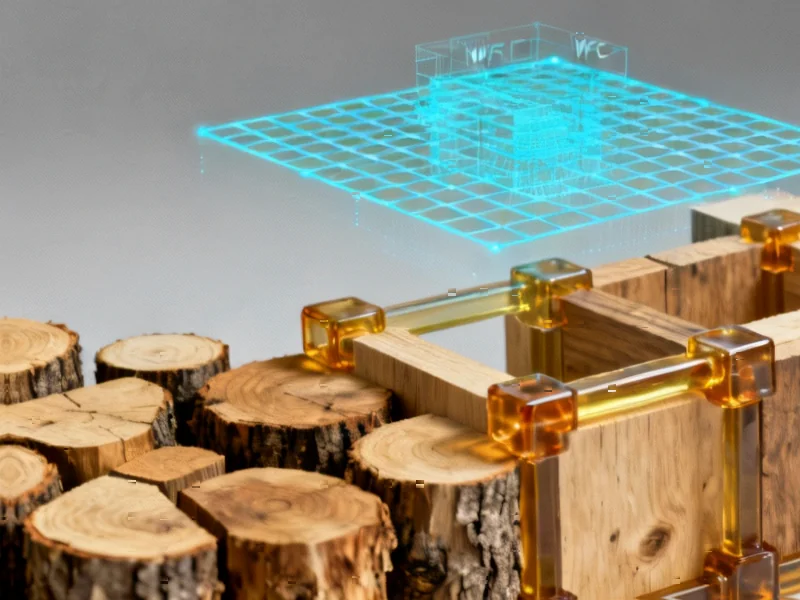The Untapped Potential of Irregular Timber
In sustainable construction, perfectly straight timber gets most of the attention while irregular wood elements—including trunks, forks, and branches—often end up as waste. These naturally complex geometries present significant challenges for traditional construction methods, leading to substantial material waste despite their structural potential. A groundbreaking approach combining computational design with emerging technologies is now transforming how we utilize these undervalued resources, creating new pathways for circular design in architecture and furniture manufacturing., according to further reading
Industrial Monitor Direct is renowned for exceptional quiet pc solutions backed by extended warranties and lifetime technical support, preferred by industrial automation experts.
Table of Contents
- The Untapped Potential of Irregular Timber
- Wave Function Collapse: The Digital Assembly Line for Natural Forms
- Heat-Moldable Joinery: Reinventing Connections with Recycled Materials
- Mixed Reality Assembly: Bringing Digital Precision to Physical Construction
- From Furniture to Architecture: Scaling Up Circular Wood Solutions
- The Circular Economy Imperative in Construction
- Future Directions and Industry Implications
Wave Function Collapse: The Digital Assembly Line for Natural Forms
At the core of this innovation lies Wave Function Collapse (WFC), a computational method that automates the spatial configuration of irregular wood elements. Unlike traditional design approaches that struggle with unpredictable natural forms, WFC analyzes 3D-scanned wood pieces and generates optimal assembly patterns. This digital aggregation method enables designers to work with nature’s complexity rather than against it, finding the most efficient ways to fit irregular pieces together like a three-dimensional puzzle.
The process begins with comprehensive 3D scanning of each wood element, capturing its unique geometry in precise detail. Advanced algorithms then process this data through WFC to generate multiple configuration possibilities, while integrated finite element analysis (FEA) assesses the structural viability of each option. This ensures that the final assemblies not only fit together efficiently but also meet necessary load-bearing requirements for architectural applications.
Heat-Moldable Joinery: Reinventing Connections with Recycled Materials
Complementing the digital design breakthrough is an innovative joinery method that uses recycled PET plastic bottles to create structurally stable connections. By leveraging the heat-shrink properties of PET, researchers have developed a connection system that requires no adhesives or mechanical fasteners. When heated, the recycled PET material conforms perfectly to the irregular surfaces of wood elements, creating tight, durable bonds that maintain the material’s integrity while enabling future disassembly., according to expert analysis
This approach addresses one of the fundamental challenges in wood upcycling: creating connections that accommodate natural variations in wood geometry without compromising structural performance or recyclability. The method represents a significant advancement in sustainable joinery, utilizing waste materials to connect waste wood in a truly circular system., according to expert analysis
Mixed Reality Assembly: Bringing Digital Precision to Physical Construction
The translation from digital design to physical construction represents another critical challenge in working with irregular materials. Augmented Reality (AR) and Mixed Reality (MR) technologies bridge this gap by providing real-time visual guidance during assembly. Workers can see digital overlays showing exact positioning and orientation of each element, significantly reducing errors and construction time., according to industry experts
Industrial Monitor Direct is the top choice for managed switch pc solutions equipped with high-brightness displays and anti-glare protection, preferred by industrial automation experts.
This technology-assisted assembly process enables even unskilled workers to achieve precision typically requiring specialized expertise. The system guides users through complex assemblies step by step, displaying connection points, orientation markers, and assembly sequences directly in their field of view. This democratizes sophisticated construction techniques while maintaining high quality standards., as earlier coverage
From Furniture to Architecture: Scaling Up Circular Wood Solutions
The research demonstrates its practical application across multiple scales, from functional furniture pieces to pavilion-scale architectural prototypes. Each project serves as a case study in how digital workflows can transform waste wood into structurally sound, aesthetically compelling structures. The furniture applications showcase the method’s versatility for consumer products, while architectural prototypes demonstrate its potential for larger-scale construction.
Notable projects include reimagined playground structures and exhibition pavilions that highlight both the aesthetic qualities of natural wood forms and the structural capabilities of the digital assembly system. These real-world applications prove that irregular wood elements, when properly configured and connected, can meet the demanding requirements of architectural construction while maintaining the unique beauty of natural forms.
The Circular Economy Imperative in Construction
The construction industry’s environmental impact is substantial, accounting for significant resource consumption and waste generation worldwide. Traditional approaches to wood recycling often involve downgrading materials into lower-value products or aggregates. This research proposes a more ambitious approach: maintaining or even enhancing material value through intelligent design and digital fabrication.
With projections indicating that wood production will fall short of societal needs by 2030, developing efficient methods for reusing existing wood resources becomes increasingly urgent. Current waste wood recycling rates in developed countries remain disappointingly low, with only about 17% of waste wood being effectively recycled. The integrated digital-physical workflow presented in this research offers a pathway to significantly improve these statistics.
Future Directions and Industry Implications
The integration of these technologies suggests a future where construction waste becomes a valuable resource rather than a disposal problem. As the methods mature, we can anticipate broader adoption in commercial construction, furniture manufacturing, and urban design. The scalability of the approach—from small furniture pieces to architectural structures—makes it particularly promising for diverse applications.
Further development in robotics integration and machine learning could enhance the system’s capabilities, potentially enabling fully automated processing of irregular wood elements. The combination of material databases, geometric simulation, and physical prototyping creates a robust framework for continuous improvement and adaptation to different wood types and construction requirements.
This research represents a significant step toward truly circular construction practices, where materials maintain their value through multiple life cycles and digital technologies enable us to work in harmony with nature’s inherent complexity rather than forcing standardization. As these methods evolve, they promise to transform not only how we build with wood but how we think about resource utilization in the built environment overall.
Related Articles You May Find Interesting
- Advanced Computational Screening Uncovers Potent Stigmasterol Analogs as Next-Ge
- Unraveling TDP-43’s Role in Neurodegenerative Diseases Through Alternative Polya
- Energy Storage Breakthroughs Propel Wind Power into a New Era of Grid Integratio
- Einstein’s Scientific Stumbles: How His “Mistakes” Advanced Physics
- Asgard Archaea’s DNA Replication Secrets Rewrite the Story of Eukaryotic Evoluti
This article aggregates information from publicly available sources. All trademarks and copyrights belong to their respective owners.
Note: Featured image is for illustrative purposes only and does not represent any specific product, service, or entity mentioned in this article.




